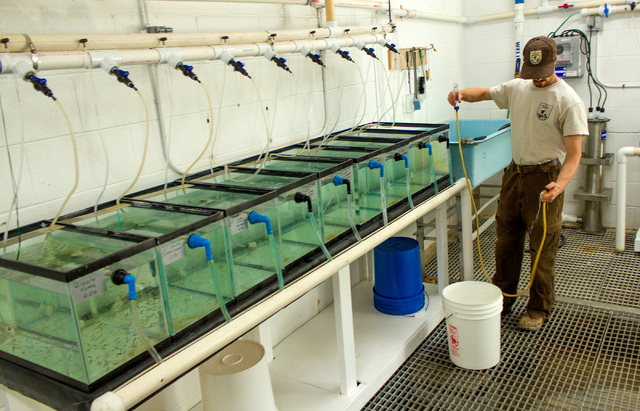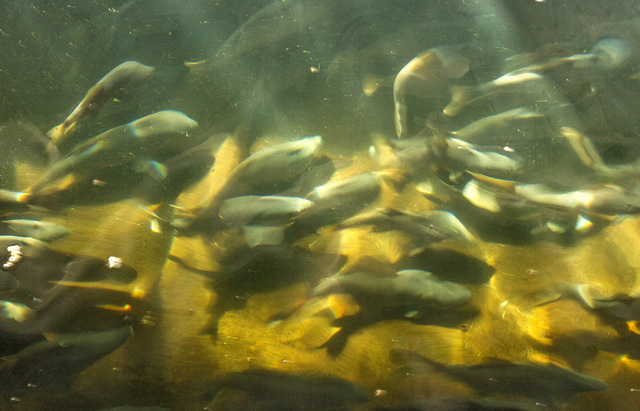Congress jumps in to fight hatchery cutbacks


Short, sweet and to the point. There really is no other way to describe HR 5026, federal legislation known simply as the Fish Hatchery Protection Act.
Introduced July 8 by Rep. Paul Gosar, R-Ariz., HR 5026 came about following the termination of rainbow trout production at the Willow Beach National Fish Hatchery, a facility designed and built for that very purpose in early 1959.
In December 2013, the U.S. Fish &Wildlife Service (FWS) announced that the Willow Beach facility would focus solely on the rearing of bonytail chub and razorback suckers, both endangered fish. The hatchery has reared endangered fish since 1973.
That decision has angered both anglers and leaders in communities that depend on the economic contributions of the Colorado River fishery, and critics are concerned that Willow Beach might just be the tip of the iceberg. Among them is Gosar.
According to his press secretary, Steven Smith, “Terminating the annual production of 150,000 rainbow trout at the Willow Beach Hatchery will stifle Arizona’s multimillion-dollar fishing industry as well as cause considerable harm to small businesses, local governments and our citizens who depend on the financial benefits associated with sports fishing. Similar impacts will be felt throughout the nation.”
Mohave County (Ariz.) Supervisor Hildy Angius recently testified before the Appropriations Committee that recreational fishing supports nearly 1,700 jobs and contributes almost $75 million annually to the county’s economy.
In its “Strategic Hatchery and Workforce Planning Report,” released in November 2013, the FWS identified budgetary issues as justification for terminating non-native fish propagation programs such as the one at Willow Beach in favor of other priorities. Those include work with endangered and native fish species. Even if funding remained level or was increased by 5 percent, “the (National Fish Hatchery System) would phase out Service funding for non-native species propagation to maintain priority programs,” the report states. That refers to the rearing of rainbow trout.
On March 5, the House Natural Resources Subcommittee on Fisheries, Wildlife, Oceans and Insular Affairs met to discuss the report. Subcommittee Chairman John Fleming, R-La., thinks the FWS is being a little shortsighted.
“From its high in 1940, the number of federal hatcheries has declined from 136 to nearly 70 today. These facilities, which average more than 70 years of age, produce and distribute 140 million fish and 120 million fish eggs with a value of over $5 billion each year. In 2011, recreational anglers took 69 million trips, they caught 345 million fish, supported 364,000 jobs, and the recreational fishing industry contributed over $70 billion to our economy,” Fleming said. “The self-fulfilling report that indicates that even if funding is increased by 5 percent, recreational propagation programs will be terminated and Service employees will be reassigned. … I intend to try to find out why the Service targeted hatcheries that produce recreational species.”
In the meantime, Rep. Gosar introduced the Fish Hatchery Protection Act (HR 5026), which reads, “The Secretary of the Interior may not permanently close, reprogram, re-purpose, decommission, significantly alter, or move to caretaker status any fish and other aquatic species propagation hatchery or propagation program within the National Fish Hatchery System of the Department of the Interior unless such action is expressly authorized by an Act of Congress.”
Some may think such a step as HR 5026 is too drastic a measure, or that it interferes with the ability of the FWS to manage its programs without political interference, but Gosar and his staff don’t think so.
“Too drastic? Congressman Gosar respectfully disagrees,” Smith said. “Requiring Congressional approval to prevent an arbitrary decision by the Fish and Wildlife Service that will kill jobs and wreck rural economies is not too drastic. What is extreme and is misguided is the fact that when asked at a Capitol Hill briefing on this subject whether USFWS considered the $28 dollar return to local economies for every dollar invested, the representative for the Fish and Wildlife Service stated that is ‘not something that factors into their decision-making.’ ”
Nevada U.S. Rep. Joe Heck joined five others as a co-sponsors of the Fish Hatchery Protection Act on Tuesday.
Freelance writer Doug Nielsen is a conservation educator for the Nevada Department of Wildlife. His “In the Outdoors” column, published Thursday in the Las Vegas Review-Journal, is not affiliated with or endorsed by the NDOW. Any opinions he states in his column are his own. He can be reached at intheoutdoorslv@gmail.com.












